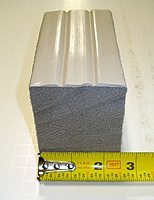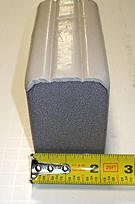Compression Set in Closed Cell Foam Joint Sealants
Coated Closed-Cell Foam Sealants–Not Equal to Precompressed, Impregnated Hybrid Sealants. Compression-set limits performance.
Why Use Impregnated Open-Cell Foam Instead of Just Closed-Cell EVA Foam?
Impregnated open-cell foam is used as the backing for precompressed hybrid sealants because it features very low compression set. In addition, precompressed foam sealants contain more material than the expected maximum joint gap which makes any compression set insignificant in the products’ intended use.
Compression set is the permanent loss of the ability to self-expand that results after a material is subject to normal compression cycles. Compression set is made worse by simultaneous exposure of certain materials to heat.
Closed-cell foams suffer on average 25% permanent compression set under movement and temperature cycles typical in construction-related structural expansion joint applications.
The most common type of closed cell foam offered as an expansion joint seal is Ethylene Vinyl Acetate or EVA. You may be familiar with products that use the letters “EVA” as part of their name. This is becasue that are made from ethylene vinyl acetate closed-cell foam.
Exploration of the suitability of EVA as the main component of an expansion joint sealant is decades old. Attempts by EMSEAL more than 25 years ago, as well as repeated more recent exploration using closed-cell EVA foam backings confirms that this approach does not offer a viable comparable alternative to acrylic-impregnated, pre-compressed products for applications involving movement typically experienced at structural expansion joints.
Despite this loss of active backpressure to compression-set, closed cell backed materials are offered as inexpensive alternatives to the precompressed sealant products.
Because the material is not supplied precompressed, it must be force-compressed in the field and because compression-set further limits the recovery, closed-cell based hybrids should not be considered equals to impregnated foam sealants.
Why not use lightweight, inexpensive closed-cell EVA backing?
"Economy" Joint Seal Composition
Compression Set in Closed-Cell "economy" Joint Seals
Permanent loss to compression set of 25% of the movement capability of the product. This means that in extension to the claimed movement of +25% (when the structure cools), this product would go into tension at the bondline and within the fragile closed cell sructure of the EVA foam backing material.
This permanent compression set results after a single 3-hour cycle with the material compressed to 1-1/2″ and heated to 150-deg.F (i.e. -25% of nominal size per movement claim at a very commonly experienced summer substrate temperature).





